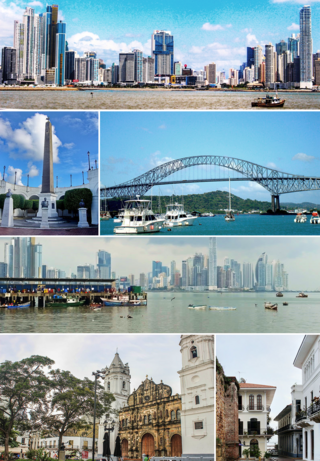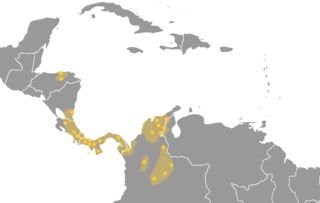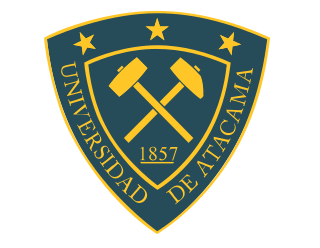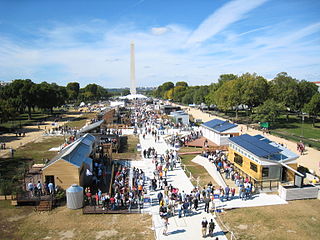
Panama City, also known as Panama, is the capital and largest city of Panama. It has a total population of 1,938,000, with over 1,500,000 in its urban area. The city is located at the Pacific entrance of the Panama Canal, in the province of Panama. The city is the political and administrative center of the country, as well as a hub for banking and commerce.

The Chibchan languages make up a language family indigenous to the Isthmo-Colombian Area, which extends from eastern Honduras to northern Colombia and includes populations of these countries as well as Nicaragua, Costa Rica, and Panama. The name is derived from the name of an extinct language called Chibcha or Muysccubun, once spoken by the people who lived on the Altiplano Cundiboyacense of which the city of Bogotá was the southern capital at the time of the Spanish Conquista. However, genetic and linguistic data now indicate that the original heart of Chibchan languages and Chibchan-speaking peoples might not have been in Colombia, but in the area of the Costa Rica-Panama border, where the greatest variety of Chibchan languages has been identified.

Catholic University of the North is a university in Chile. It is part of the Chilean Traditional Universities. It is located in Antofagasta, Chile. The Catholic University of the North was founded on May 31, 1956.

University of Atacama or UDA is a university in Chile. It is part of the Chilean Traditional Universities. UDA is in Copiapó, in the Third Region, Atacama.

The University of Talca is a Chilean university located in the cities of Talca, Curicó, Linares, Santa Cruz and Santiago. Its headquarters and largest campus are located in the city of Talca. It is part of the Chilean Traditional Universities, the Consortium of State Universities and the Group of Regional Universities of Chile.
Universidad Católica, Spanish for "Catholic university", may refer to:

The National Technological University is a country-wide national university in Argentina, and considered to be among the top engineering schools in the country. Hosting over 85,000 students, its student body is comparable to Argentina's third-largest university and exceeded significantly only by the University of Buenos Aires (UBA). It has 29 semi-independent branches of various sizes located all over the country.

The Universidad Distrital Francisco José de Caldas is a public, coeducational, research university based in Bogotá, Colombia. It is the second most important public higher education institution in the city, after the National University of Colombia, with a population of 26,140 students. It was founded in 1948, by Priest Daniel de Caicedo, who would become its first rector, with the support of the Bogotá City Council, as the Municipal University of Bogotá. It changed its name to the current in 1957 when the municipality of Bogotá became a district. Its establishment was officialized by the 1970 decree No. 1030, issued by the national government. The university offers 70 programs at undergraduate and postgraduate levels, including four masters and one doctorate.
The Central American Technological University (Spanish: Universidad Tecnológica Centroamericana) (UNITEC) is a private coeducational institution with campuses in the three main cities of Honduras: Tegucigalpa, San Pedro Sula and La Ceiba.

A national university is mainly a university created or managed by a government, but which may also at the same time operate autonomously without direct control by the state.
The Columbus University, is an institution of higher education, established on October 12, 1992. It is authorized by the Panamanian Ministry of Education. It is recognized as a private university, by the Panamanian State, through Executive Decree No. 112, dated February 25, 1994 and published in the Official Gazette No. 22-492 of March 11, 1994. All its academic programs are approved by the State Universities responsible for its operation: Universidad de Panamá and Universidad Tecnológica de Panamá.
The Technological University of Panama, Universidad Tecnológica de Panamá (UTP) in Spanish, is the second largest university in Panama. It comprises six schools and has seven regional campuses nationwide. The main campus is a 60-hectare (150-acre) piece of land in Panama City, the country's capital.
Universidad Alas Peruanas is a university located in Lima, Peru, founded on April 26, 1996, by Joaquin Ramirez thorough an Cooperativa Alas Peruanas, composed of members of the Peruvian Armed Forces.

The European University of the Atlantic, or UNEATLANTICO, is a private Spanish university located in the Scientific and Technological Park of Cantabria (PCTCAN), in the city of Santander, Cantabria.

The Solar Decathlon is an initiative of the Department of Energy of the United States (DOE) in which universities around the world compete with the design and construction of sustainable housing that works 100% with solar energy. It is called “Decathlon" since universities and their prototypes are evaluated in 10 criteria: architecture, engineering and construction, energy efficiency, energy consumption, comfort, sustainability, positioning, communications, urban design and feasibility and innovation.